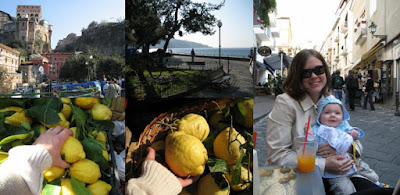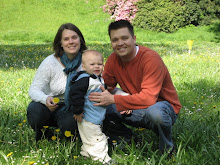Over Easter break (Europe Easter = 2 days of company holiday), we decided to check out Italy. Everyone that we know who has been there says nothing compares. Our good friend Phil (who has lived in England for 2 years and is moving back to the States this June) said his two favorite places to visit were Iceland and Naples. So, with that advice in mind, we were off to Naples.


This trip to Italy was a bit difficult. We booked the trip late and over a very busy holiday weekend, so our “cheap” transportation options were very limited. In the end, we did find a fairly cheap ticket, but it involved stops in Milan and Rome before Naples. That may sound cool on the outside, but people aren’t raving about Milan and Rome’s airports.
At first we didn’t know what we had gotten into. After we arrived in Naples and caught the first bus to Sorrento, the bus driver drove us through 90 minutes of the most jam-packed, graffiti polluted, low-income neighborhoods we have ever seen. It looked just as bad as the most depressed areas in Houston. I guess we just assumed everything in Italy was going to look like paradise; it didn’t.
Luckily, our final destination looked much different. Just as you might expect, Sorrento was beautiful. The town is built on a mountain that quickly dives into the Mediterranean Sea. Clay rooftops and waterfalls speckle the landscape with narrow 3-4 story buildings lining the speedy two lane highways. And, the mix of lemon trees and salty sea air created the perfect cap to this tropical paradise. It was like walking into a movie.
The greatest aspect of Sorrento is that you’re not limited to the city itself. Within a 30 mile radius you can also find the Almalfi Coast, the Island of Capri, and Pompeii. Since we had three full days in the area we decided to spend 1 day at each location.
The first stop was the Island of Capri. Capri was made famous when Tiberius “the resentful” Caesar (14-37AD) claimed Capri as his imperial villa. He ruled from Capri for many years and built his palace on top of Capri’s highest point. Today, the ruins still lay and are a great spot for tourists.
On Friday morning, we arrived in Capri by boat. Wow! Neither of us had seen the Mediteranian before, so we were completely amazed by the deep blue and clear water. You could see the bottom through 100 ft of water and the blue was dark like a “blue” Crayola crayon.
There isn’t much to do on the waterfront (except take pictures of the scenery), so we hopped on the cable car for a ride to the city center. The center-top and bottom-right pictures are just after the cable car ride.
From the city center you basically have two options: (1) take a bus to the opposite side of the mountain to see the Grotto and (2) walk to Tiberius’ ruins. We opted for the ruins and started that way. Before going, however, we had a slight detour.
Another downside to our “late-planned / multiple stop” flight to Sorrento was the airline lost our stroller. The luggage came without any problems (thankfully), but the stroller was gone. Originally, we thought we could get by without it and just carry Jacob in the Baby Bjorn. After about 30 minutes of walking we changed our mind and bought another stroller.
The Chicco dealer was very close to the city center and had the most incredible view of the ocean (I can’t imagine the overhead). They were extremely pleasant people. They helped us find the right stroller and also pointed us in the right direction for Tiberius’ ruins. And, even after we left, the owner tracked us down and retuned Jacob’s jacket that we left in the store - truly kind people.

By the way… In case you were wondering… We did successfully negotiate with the airline to reimburse us for the new stroller. Actually --- Amanda pulled that one off.
The walk to the ruins was about 4 miles long and all uphill. But, it was a nice day and worth the extra effort. Along the way we found this great little restaurant built into the mountain. Amanda had the ravioli and I the seafood pasta; it was the best meal of the trip. The seafood was fresh and the pasta was homemade. Unbelievable!
With the ruins in sight we kept trudging up the hill. Thankfully, we passed lots of great picture places. This gave good reason for breaks and a needed distraction from the difficult trek. The ruins didn’t disappoint us. There is just something odd about walking through 2000 year old structures. One thing is certain - the ruins weren’t built for strollers. So, we carried Jacob (and the stroller) up every step in the place - probably 200-300 steps.
We ended the day with a return trip boat ride back to Sorrento. We thought nothing could be more impressive than Capri / Sorrento’s coastline, but we were wrong. We hadn’t seen the Almafi coast yet.
If you look at a map, Sorrento is on a “kind-of” peninsula. It isn’t like Florida, but still has water on three sides. It is a very mountainous region with very high cliffs. The Almalfi Coast lies on the opposite side of Sorrento.
The hotel recommended a bus ride to and from Almafi. The bus ride was a little rough: very winding, lots of speed changes, and tons of hills. It was the kind of ride that will really turn your stomach. On the other hand though, the scenery was breathtaking.
We weren’t able to get any pictures on the bus, but we did find a few good shots after we got there. The pictures below are of both Amalfi and Positano.
Once we got to Almafi we learned it had something for everyone: small town atmosphere, beautiful scenery, a grotto, kayak polo, and good ice cream.
The pictures below are of the side trip to a Grotto. A grotto is a sealed cave (no light enters through the air) where the “cave opening” is under water. As the light goes through the cave opening it casts a deep blue glow on the entire room. This particular grotto was featured by 60 minutes about 20 years ago.
While we were there a group of people were playing kayak polo. The game was really impressive because the only used the oars to move the ball. They passed it back and forth without dropping and threw it toward a cage raised off the water ~10ft.
Probably the most unexpected piece of the trip was the Amalfi Church. We almost didn’t make time for it; the boat back to Sorrento was leaving in 1 hr and we would have to carry Jacob up 30 steps. It was almost too much to work up the energy for.
As churches go it was good, but not incredible. I mean the paintings were old and neat looking, but not differential to other churches. The differential part was the basement crypt. This crypt held St. Andrew – the disciple of Jesus. The top left and right pictures are the tomb under which St. Andrew’s head (or skull) is still kept.
If you think that walking through a 2000 year old building is impressive, imagine standing within 10ft of Jesus’ disciple. Incredible!
The last day in Italy was saved for Pompeii and Vesuvius. Almost everyone has heard of Pompeii. It is the Roman town that was buried under 30-50 feet of ash when Mount Vesuvius erupted in 79AD. And, true to its form and the documentaries, it is still in the same position it was when the town was buried.
Amanda and I found the engineering and the artwork surprisingly sophisticated. The Romans really had a good life back then. I guess it is easy for us to think life 2000 years ago was just open fires in cold, dark caves. Pompeii proved to us they really had a comfortable life. They had (a) running water in lead pipes (lead wasn’t such a good choice, but as soon as the calcium deposits built up, the people stopped dying of poisoning), (b) well constructed stone buildings, (c) artistic mosaic tiling, (d) elections (papyrus political propaganda – posters – were found in the ashes --- there was an election just around the corner when Pompeii was buried), (e) water basins with iron keys to seal the edges, (f) street signs, (g) neighborhoods, (h) fountains, (i) theatres, (j) centralized city planning, etc.
Toward the end of the tour our guide showed us the “masterpiece of Pompeii” (shown in the bottom left picture below). This was uncovered just 150 years ago. Amazing, right? The painting was perfectly preserved in the ash.
Another interesting point was that Pompeii was lost for about 1600 years. It wasn’t until a farmer accidentally tilled up an artifact in the mid-1700’s that they realized what was beneath the ground. The picture on the top-right shows what it looked like before it was found – just a grassy knoll.
It seems odd that Rome or other neighboring towns wouldn’t have record of it, but I guess it was forgotten.
Unfortunately, an earthquake devastated the town in 62AD and the town was still trying to rebuild from that point. So, you can’t get the full appreciation of the architecture because much was lost in the earthquake.
You can’t visit Pompeii without seeing Vesuvius. So, after walking through the ruins we bussed over to Vesuvius and started our walk up the volcano. The walk was much more difficult than we expected (especially with Jacob in the Baby Bjorn). But, we started the hike.
It is interesting to be so close to an active volcano. The experts say the volcano should erupt every 30 years and the last explosion was in 1944. So, the volcano is overdue. It is also interesting to see all the people living on the Volcano. They know they will be killed if the volcano erupts, but they stay because tourists are a good source of cash flow.
We got back from our excursion at ~6pm, ate at the hotel restaurant and hit the sack early. The next morning we caught a cab to the airport at 6am. The vacation was over.












1 comment:
Completely jealous, Kirt and I want to visit the Amalfi coast!
Post a Comment